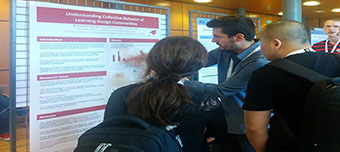GTI Learning participates in EC-TEL 2016
GTI Learning participates in EC-TEL 2016
GTI Learning participated in 11th European Conference on Technology Enhanced Learning (EC-TEL2016) held in Lyon, France from 13th to 16th September, 2016. Kalpani Manathunga and Konstantinos Michos participated in the workshops conducted in parallel to the main EC-TEL conference. Konstantinos presented a paper, “Towards understanding the potential of teaching analytics within educational communities” at the “4th International Workshop on Teaching Analytics” (IWTA’16). Kalpani participated in Connecting Learning Design and Learning Analytics (CLAD) workshop co-organized by Davinia Hernández-Leo and the topic of the paper was “Connecting pattern-based learning designs with analytics: The case of the PyramidApp”.

Manathunga, K., Hernández-Leo, D., PyramidApp: Scalable method Enabling Collaboration in the Classroom. In: Proceedings of 11th European Conference on Technology Enhanced Learning, EC-TEL 2016, Lyon, France, September 2016, LNCS 9891, 422- 427.
Abstract : Computer Supported Collaborative Learning methods support fruitful social interactions using technological mediation and orchestration. However, studies indicate that most existing CSCL methods have not been applied to large classes, means that they may not scale well or that it’s unclear to what extent or with which technol
ogical mechanisms scalability could be feasible. This paper introduces and evaluates PyramidApp, implementing a scalable pedagogical method refining Pyramid (aka Snowball) collaborative learning flow pattern. Refinements include rating and discussing to reach upon global consensus. Three different face-to-face classroom situations were used to evaluate different tasks of pyramid interactions. Experiments led to conclude that pyramids can be meaningful with around 20 participants per pyramid of 3–4 levels, with several pyramids running in parallel depending on the classroom size. An underpinning algorithm enabling elastic creation of multiple pyramids, using control timers and triggering flow awareness facilitated scalability, dynamism and overall user satisfaction in the experience.
Michos, K., & Hernández-Leo, D.,Understanding Collective Behavior of Learning Design Communities. In: Proceedings of 11th European Conference on Technology Enhanced Learning, EC-TEL 2016, Lyon, France, September 2016, LNCS 9891, 614-671.
Abstract : Social computing enables collective actions and social interaction with rich exchange of information. In the context of educators’ networks where they create and share learning design artifacts, little is known about their collective behavior. Learning design tooling focuses on supporting educators (learning designers) in making explicit their design ideas and encourages the development of “learning design communities”. Building on social elements, this paper aims to identify the level of engagement and interactions in three communities using an Integrated Learning Design Environment (ILDE). The results show a relationship between the exploration of different artifacts and creation of content in all the three communities confirming that browsing influence the community’s outcomes. Different patterns of interaction suggest specific impact of language and length of support for users.
